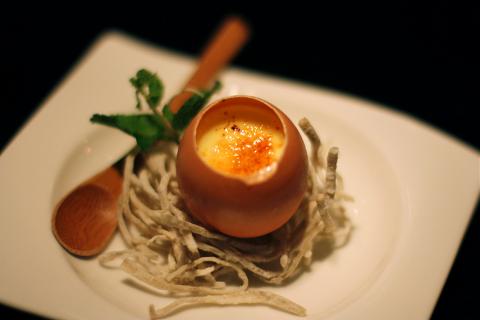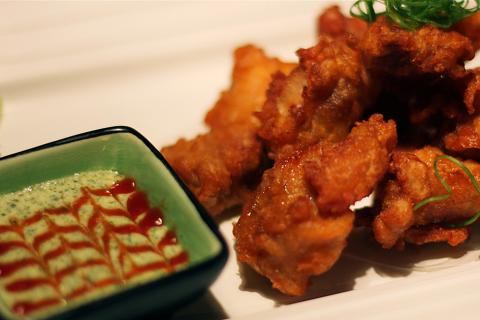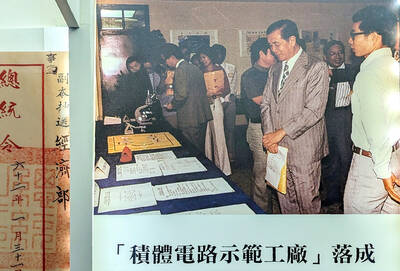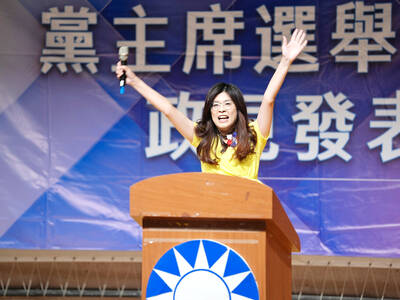A joint collaboration between music promoter Brown Sugar Live and Bagayalo Creative Workshop, Dozo Izakaya’s (Dozo創作和食居酒屋) cavernous space on Guangfu South Road (光復南路) near Civil Boulevard (市民大道) resembles an upscale nightclub, with dramatic lighting and sleek wooden walkways that will make you feel like a supermodel — unless your strut ends with a tumble into the sunken dining area or one of the surrounding booths.
You have to be extra careful if you order one of Dozo signature 4-liter Taiwan or Orion draft beers, which are served in tall glass dispensers. Other drinks from Dozo’s prodigious selection of alcoholic beverages include house cocktails like the surprisingly strong Mitsuwari peach (whisky, peach syrup, honey and soda, NT$200), or the sweet and sour samurai (shochu, whisky, triple sec and lemon juice, NT$200), Dewards, Macallan, Glenfiddich and Aberfeldy whiskies, champagne, and, of course, sake.
Dozo’s large menu is divided into 13 sections (with a table of contents in the front) and includes izakaya staples like sushi and grilled meats. The food, though not particularly innovative, is tasty and attractively presented.

PHOTOS: CATHERINE SHU, TAIPEI TIMES
To prepare yourself for that 4-liter draft beer, try Japanese fried chicken with tartar sauce (NT$180) or the skewered grilled beef (NT$190), which is wrapped around a large bundle of sliced scallions. Lighter treats include steamed mussels in sake broth (NT$260). Our portion included a paltry six mussels, but the shellfish were tender and juicy. Dozo’s signature Caesar salad with a hot spring egg (NT$200) has an interesting melange of textures, including jelly cubes made from soy sauce, a poached egg and croutons.
Presented like a work of art in a shallow wooden box, the seven-spices tuna tartar (NT$180, listed as “pate” in English on the menu) is one of Dozo’s most interesting looking dishes, but after the ingredients were mixed up and served on crispy romaine lettuce leaves, the tartar’s flavor proved to be disappointingly bland. Dozo’s sashimi plates and sushi rolls are basic but good. The grilled beef sushi roll (NT$220) is topped with fresh tender meat and peppercorns, giving it an unexpected kick.
Dozo’s dessert menu is tiny, but most of the treats are priced under NT$100 and as fun to look at as they are to eat. The creme brulee (NT$60), for example, is served in an eggshell on top of strips of crispy fried burdock. An ice cream dish for the same price is plated alongside a slice of sweet yam and ball of spun sugar. For parties, you can reserve a Black as Chocolate cake to be served after your meal. Revelers who want their sweet to come with a bite can order the Black Forest milk shake, which is made with blueberry liqueur, Kahlua and topped with chocolate ice cream (NT$280).

PHOTOS: CATHERINE SHU, TAIPEI TIMES

PHOTOS: CATHERINE SHU, TAIPEI TIMES

Oct. 27 to Nov. 2 Over a breakfast of soymilk and fried dough costing less than NT$400, seven officials and engineers agreed on a NT$400 million plan — unaware that it would mark the beginning of Taiwan’s semiconductor empire. It was a cold February morning in 1974. Gathered at the unassuming shop were Economics minister Sun Yun-hsuan (孫運璿), director-general of Transportation and Communications Kao Yu-shu (高玉樹), Industrial Technology Research Institute (ITRI) president Wang Chao-chen (王兆振), Telecommunications Laboratories director Kang Pao-huang (康寶煌), Executive Yuan secretary-general Fei Hua (費驊), director-general of Telecommunications Fang Hsien-chi (方賢齊) and Radio Corporation of America (RCA) Laboratories director Pan
The consensus on the Chinese Nationalist Party (KMT) chair race is that Cheng Li-wun (鄭麗文) ran a populist, ideological back-to-basics campaign and soundly defeated former Taipei mayor Hau Lung-bin (郝龍斌), the candidate backed by the big institutional players. Cheng tapped into a wave of popular enthusiasm within the KMT, while the institutional players’ get-out-the-vote abilities fell flat, suggesting their power has weakened significantly. Yet, a closer look at the race paints a more complicated picture, raising questions about some analysts’ conclusions, including my own. TURNOUT Here is a surprising statistic: Turnout was 130,678, or 39.46 percent of the 331,145 eligible party

The classic warmth of a good old-fashioned izakaya beckons you in, all cozy nooks and dark wood finishes, as tables order a third round and waiters sling tapas-sized bites and assorted — sometimes unidentifiable — skewered meats. But there’s a romantic hush about this Ximending (西門町) hotspot, with cocktails savored, plating elegant and never rushed and daters and diners lit by candlelight and chandelier. Each chair is mismatched and the assorted tables appear to be the fanciest picks from a nearby flea market. A naked sewing mannequin stands in a dimly lit corner, adorned with antique mirrors and draped foliage

The election of Cheng Li-wun (鄭麗文) as chair of the Chinese Nationalist Party (KMT) marked a triumphant return of pride in the “Chinese” in the party name. Cheng wants Taiwanese to be proud to call themselves Chinese again. The unambiguous winner was a return to the KMT ideology that formed in the early 2000s under then chairman Lien Chan (連戰) and president Ma Ying-jeou (馬英九) put into practice as far as he could, until ultimately thwarted by hundreds of thousands of protestors thronging the streets in what became known as the Sunflower movement in 2014. Cheng is an unambiguous Chinese ethnonationalist,